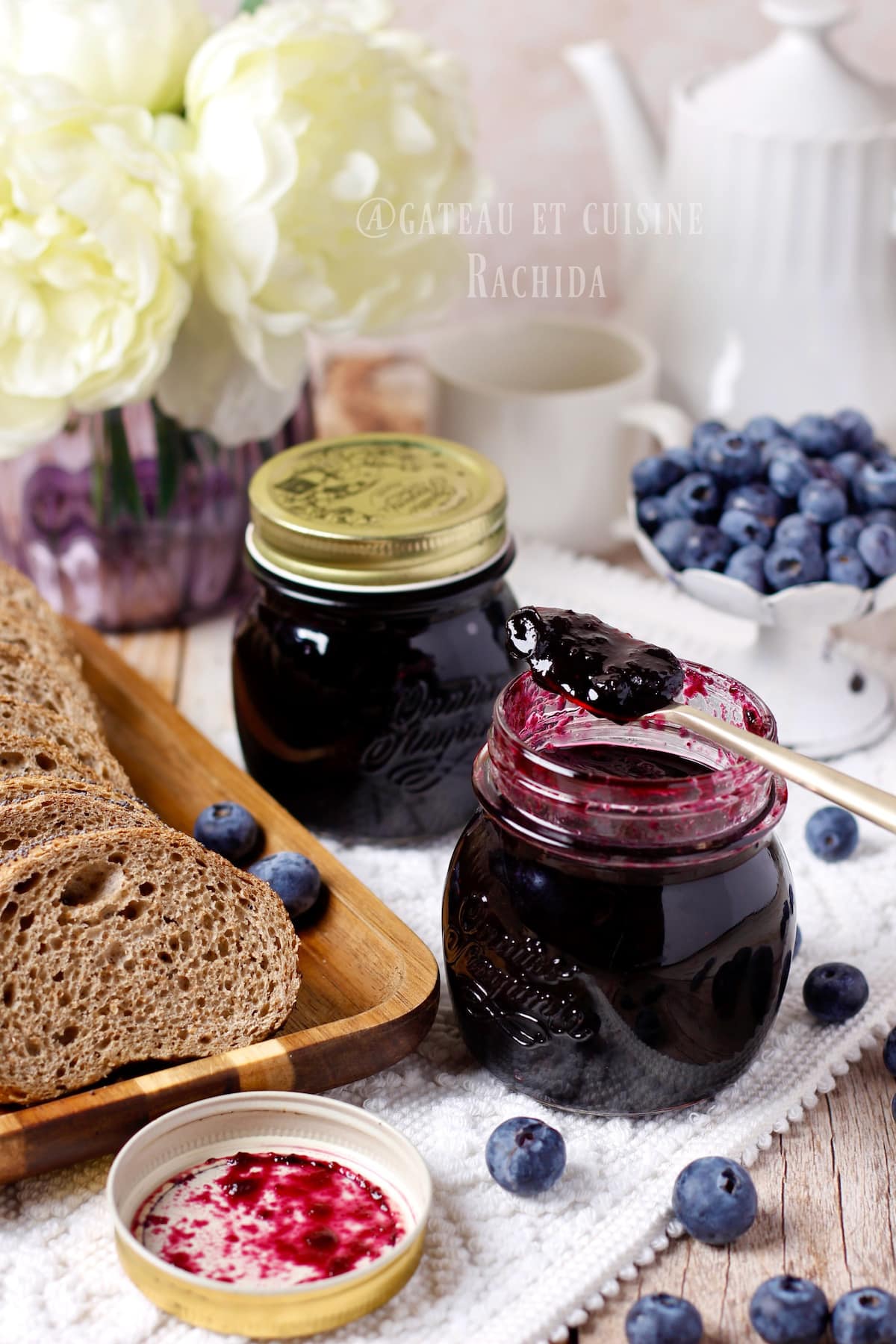
It’s ideal for adding variety to your breakfasts or enhancing children’s snacks. Made with fresh blueberries, this jam combines the berries’ natural sweetness with their intense flavor.
Simply spread it on a slice of bread or serve it alongside crepes and pancakes to enjoy the vitamins of blueberries all year round. These small jars also make wonderful homemade gourmet gifts, appreciated for their authentic flavor and deliciously fruity, natural taste.
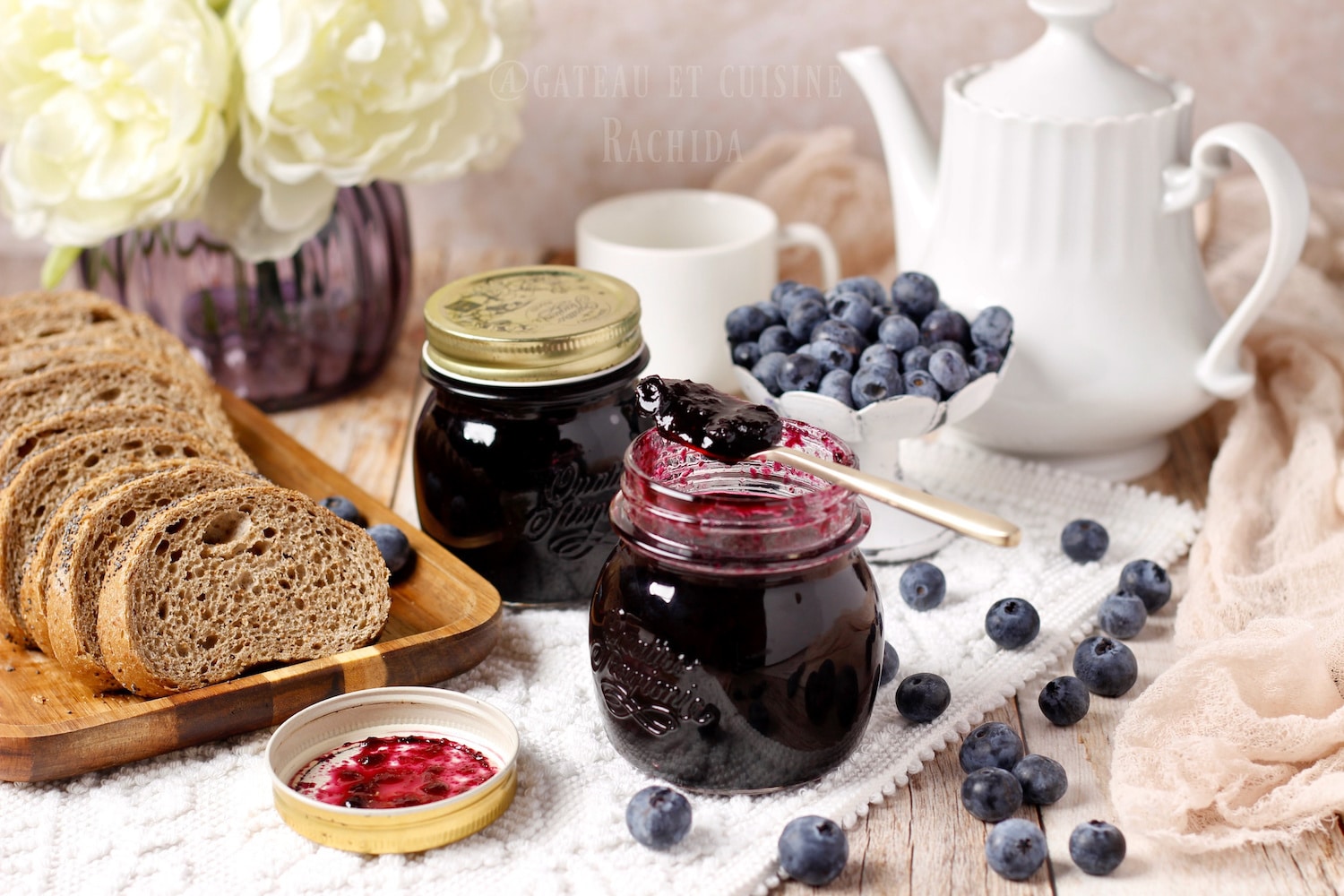
Table of Contents
What you’ll love about this blueberry jam
Authentic Flavor: The natural and intense taste of blueberries, both sweet and slightly tangy.
Smooth Texture: Perfect for spreading on bread or crepes, with an ideal balance of creaminess and fruit pieces, offering a delightful taste experience.
Nutritional Benefits: A natural source of vitamins and antioxidants.
Intense Color: A rich, deep purple that is captivating and elegant, reflecting the richness and quality of the small blueberries used.
Homemade: The joy of savoring or gifting an artisanal product.
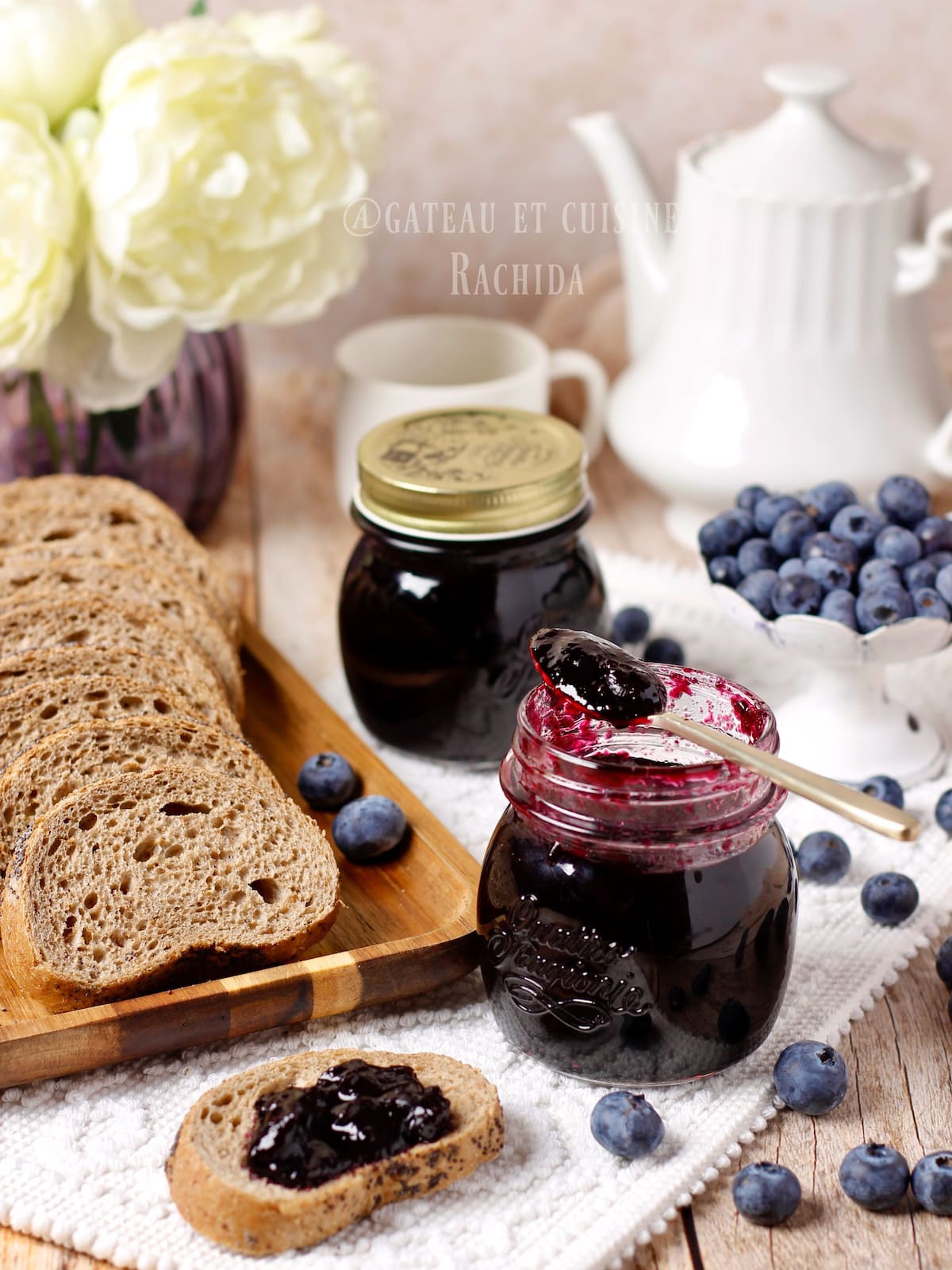
Tips and tricks for a perfect blueberry jam
You can also see my article on how to make a successful jam
1. Choose quality blueberries: Use fresh, fully ripe blueberries to make a jam rich in flavor. Sort through them to remove any spoiled or damaged berries.
2. Let them macerate: Before cooking, mix the blueberries with sugar and let them macerate for at least 2 hours, preferably overnight. This allows the fruit to release its juice, intensify its flavor, and speed up the cooking process.
3. Adjust the amount of sugar: For 1 kg of blueberries (net weight), it is recommended to use at least 700 g of sugar. If you choose to use less sugar, the jam’s shelf life will be shorter. The less sugar you use, the less the jam will set. In this case, you will need to store it in the refrigerator and consume it quickly.
4. Cook on high heat: A quick cooking process helps preserve the nutrients, flavor, and color of the fruit.
5. Prevent foam: As soon as the mixture reaches a boil, add a knob of butter to prevent the formation of foam.
6. Monitor and stir often: During cooking, stir regularly to prevent the jam from sticking or burning and to achieve a uniform texture. If you prefer a smoother jam, mash the fruit with a potato masher at this stage.
7. Check the consistency: To test the consistency, pour a small amount of jam onto a plate that has been chilled in the freezer and let it cool for a few seconds. If it sets slightly and doesn’t run, the jam is ready. If not, continue cooking for a few more minutes.
8. Sterilize the jars: Before starting the jam-making process, sterilize the jars to ensure long-term preservation. To sterilize, boil the jars in water for 15 minutes, then let them air dry.
9. Fill the jars: Pour the hot jam into the sterilized jars and seal them immediately. Turn the jars upside down to create a vacuum seal, which helps with preservation.

Preparation steps
NB: For full details of ingredients, see the recipe card at the end of this article, which you can print out. Below are the instructions, which you can also view in images.
Macerate:
1. Wash the blueberries thoroughly under cold water and drain them well. Sort through them to remove any spoiled ones. Prepare a little more than the final quantity needed for the recipe.
2. Place the blueberries in a large pot or jam pan. Add the sugar, water, and lemon juice, and mix everything together well.
3. Let the mixture macerate for at least 2 hours at room temperature, or preferably overnight in the refrigerator. This step allows the blueberries to release their juice and the sugar to begin dissolving, which helps speed up the cooking process.
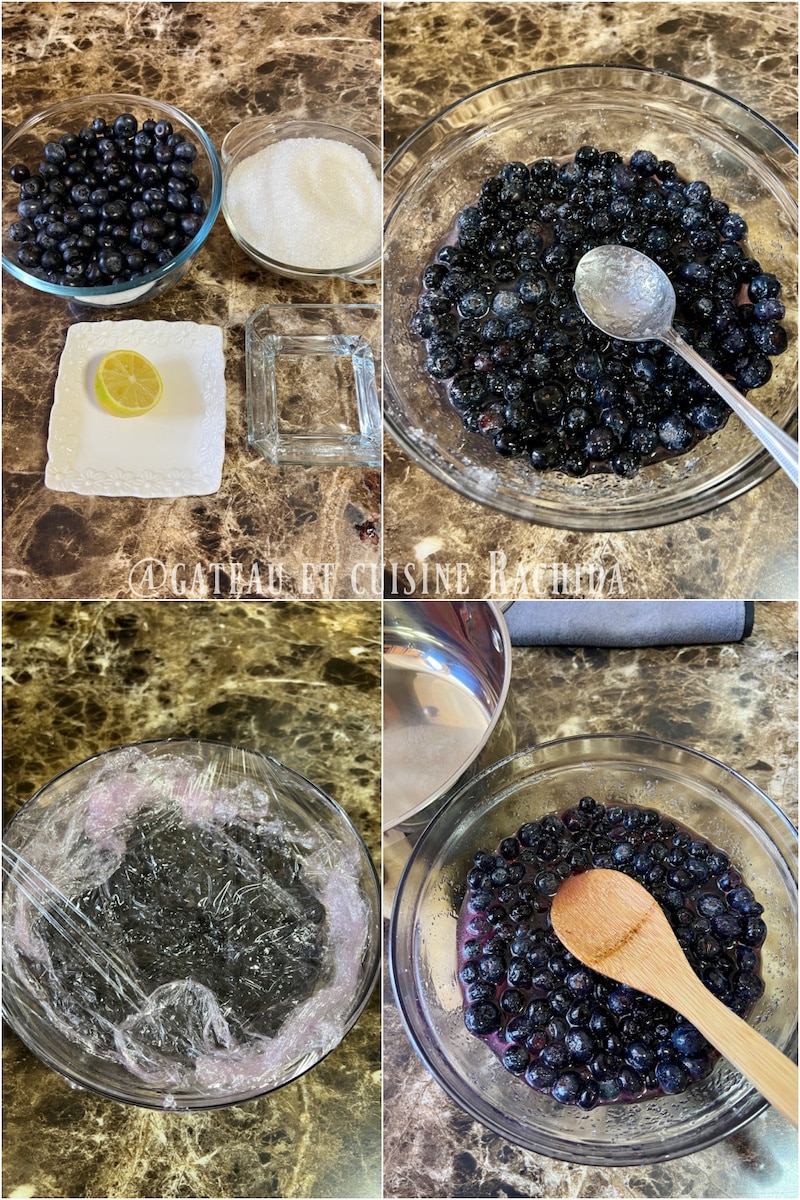
Sterilizing the jars:
After the maceration time, sterilize the jars and lids by washing them thoroughly. Boil them in water for 15 minutes, then turn them upside down on a clean cloth and let them air dry. Alternatively, you can sterilize them in the oven at 140°C (284°F).
Cooking the Jam:
1. Stir the blueberries and the syrup that has formed, then place the pot over high heat.
2. Once the mixture comes to a boil, add a small knob of butter to stop the foam. Stir regularly.
3. Cook for 13 to 15 minutes from the start of boiling. After 5 minutes, lower the heat to medium and continue cooking.
You can use a potato masher to crush the fruits more, depending on the desired consistency of the jam.
4. During cooking, foam may form on the surface despite the knob of butter. Remove it towards the end of the cooking process using a skimmer.
5. Check the consistency by placing a small spoonful of jam on a very cold plate, taken out of the freezer. Tilt the plate slightly; if the jam sets and doesn’t run quickly, it’s ready. If not, continue cooking for a few more minutes and test again.
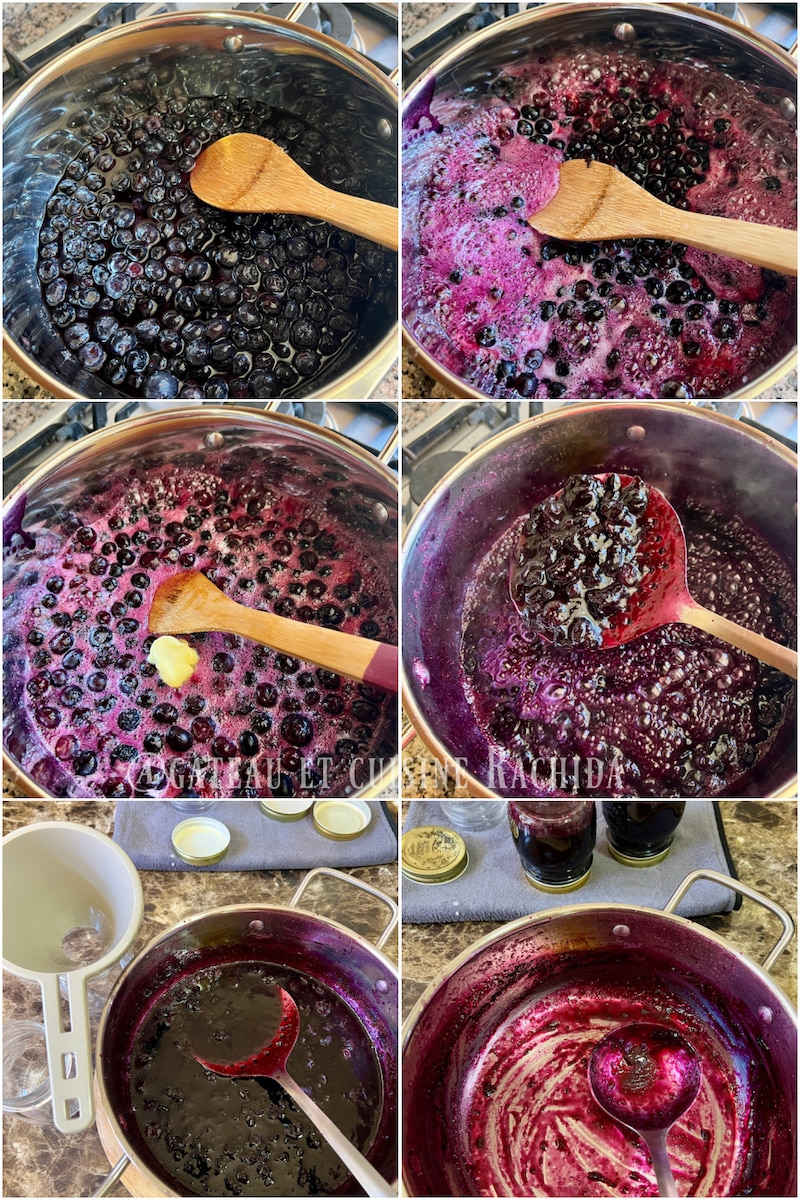
Jarring:
1. Once cooking is finished, remove the jam from the heat and, while still hot, pour it into the sterilized jars using a ladle and funnel, if possible.
2. Fill the jars to about 1 cm from the top. Wipe the rims of the jars if necessary, then seal them immediately with the lids.
3. Turn the jars upside down on a cloth and let them cool completely. After an hour, check that the lids are still tightly sealed.
4. Once cooled, store the jars in a dry place away from light. Once opened, keep the jar in the refrigerator and consume it within the following weeks.
Other jam recipes:
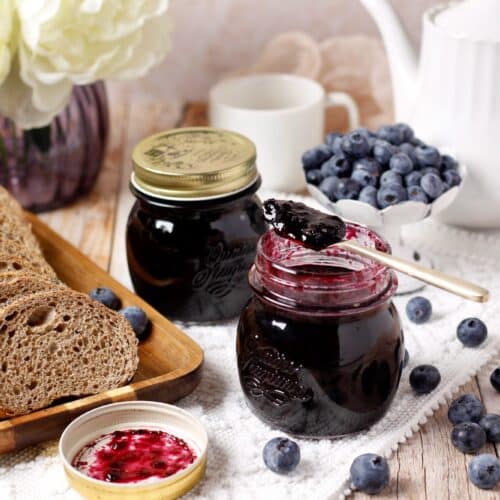
Homemade blueberry jam
EQUIPEMENTS
INGREDIENTS
- 600 g fresh blueberries, washed and sorted
- 420 g sugar
- Juice of 1/2 lemon
- 100 ml water
- 1 small knob of butter optional
PREPARATION
Macerate:
- Wash the blueberries thoroughly under cold water and drain them well. Sort through them to remove any spoiled ones. Prepare a little more than the final quantity needed for the recipe.
- Place the blueberries in a large pot or jam pan. Add the sugar, water, and lemon juice, and mix everything together well.
- Let the mixture macerate for at least 2 hours at room temperature, or preferably overnight in the refrigerator. This step allows the blueberries to release their juice and the sugar to begin dissolving, which helps speed up the cooking process.
Sterilizing the jars:
- After the maceration time, sterilize the jars and lids by washing them thoroughly. Boil them in water for 15 minutes, then turn them upside down on a clean cloth and let them air dry. Alternatively, you can sterilize them in the oven at 140°C (284°F).
Cooking the Jam:
- Stir the blueberries and the syrup that has formed, then place the pot over high heat.
- Once the mixture comes to a boil, add a small knob of butter to stop the foam. Stir regularly.
- Cook for 13 to 15 minutes from the start of boiling. After 5 minutes, lower the heat to medium and continue cooking.
- You can use a potato masher to crush the fruits more, depending on the desired consistency of the jam.
- During cooking, foam may form on the surface despite the knob of butter. Remove it towards the end of the cooking process using a skimmer.
- Check the consistency by placing a small spoonful of jam on a very cold plate, taken out of the freezer. Tilt the plate slightly; if the jam sets and doesn't run quickly, it's ready. If not, continue cooking for a few more minutes and test again.
Jarring:
- Once cooking is finished, remove the jam from the heat and, while still hot, pour it into the sterilized jars using a ladle and funnel, if possible.
- Fill the jars to about 1 cm from the top. Wipe the rims of the jars if necessary, then seal them immediately with the lids.
- Turn the jars upside down on a cloth and let them cool completely. After an hour, check that the lids are still tightly sealed.
- Once cooled, store the jars in a dry place away from light. Once opened, keep the jar in the refrigerator and consume it within the following weeks.
Thank you for visiting my blog and your comments.
You can also follow me on my YouTube channel
